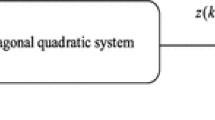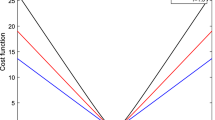Abstract
Ignoring nonlinear effects in many practical situations degrades the performance. This paper considers nonlinear system characterization using higher-order cumulants and polyspectra. A novel method to blindly identify the kernels of cubic systems using mixed third- and fourth-order cumulants is developed. We study the link between the Fourier transform of third-order and fourth-order cumulants in nonlinear cubic systems. Then, we use the inverse Fourier transform to build a new formula which combines third- and fourth-order cumulants. Then, we generalize it to the nth-order cumulants and the kernels of nonlinear cubic systems driven by a non-Gaussian random signal, independent, identically distributed (i.i.d.) in Gaussian noise environment. Our performances results indicate that the proposed approach is able to identify blindly the kernels in cubic systems.









Similar content being viewed by others
References
Alshebeili, S.A., Alsehaili, M.A., Alkanhal, M.A.: Cumulants and genetic algorithm LFor parameters estimation of noncausal autoregressive models. Int. J. Model. Simul. 22(3), 186–196 (2002)
Abderrahim, K., Mathlouthi, H., Msahli, F.: New approaches to finite impulse response systems identification using higher-order statistics. IET Signal Process. 4(5), 488–501 (2010)
Zidane, M., Safi, S., Sabri, M. and Boumezzough, A.: Identification and equalization using higher order cumulants in MC-CDMA systems. In: 2014 5th Workshop on Codes, Cryptography and Communication Systems (WCCCS), pp. 81–85. IEEE (2014)
Mileounis, G., Kalouptsidis, N.: Blind identification of second order Volterra systems with complex random inputs using higher order cumulants. IEEE Trans. Signal Process. 57(10), 4129–4135 (2009)
Xu, X., Wang, F., Qian, F.: Support vector machine and higher-order cumulants based blind identification for non-linear Wiener models. IET Signal Process. 12(6), 761–769 (2018)
Bai, B., Zhang, L.: HOC based blind identification of hydroturbine shaft Volterra system. Shock Vib. (2017)
Zidane, M., Safi, S., Sabri, M.: Extending HOC-based methods for identifying the diagonal parameters of quadratic systems. Signal Image Video Process. 12(1), 125–132 (2018)
Tseng, C.H., Powers, E.J.: Identification of cubic systems using higher order moments of iid signals. IEEE Trans. Signal Process. 43(7), 1733–1735 (1995)
Tan, H. Z., Aboulnasr, T.: TOM-based blind identification of cubic nonlinear systems. I: 2004 IEEE International Conference on Acoustics, Speech, and Signal Processing, Vol. 2, pp. II-873. IEEE (2004)
Guerreiro, J., Dinis, R., Montezuma, P.: On the use of equivalent nonlinearities for studying quantization effects on sampled multicarrier signals. IET Elec. Lett. 51(2), 151–153 (2015)
Guerreiro, J., Dinis, R., Montezuma, P.: Equivalent nonlinearities for studying nonlinear effects on sampled OFDM signals. IEEE Commun. Lett. 19(4), 529–532 (2015)
Guerreiro, J., Dinis, R., Montezuma, P., da Silva, M.M.: On the achievable performance of nonlinear MIMO systems. IEEE Commun. Lett. 23(10), 1725–1729 (2019)
Teodoro, S., Silva, A., Dinis, R., Barradas, F.M., Cabral, P.M., Gameiro, A.: Theoretical analysis of nonlinear amplification effects in massive MIMO systems. IEEE Access 7, 172277–172289 (2019)
Madeira, J., Guerreiro, J., Dinis, R.: Iterative frequency-domain detection and compensation of nonlinear distortion effects for MIMO systems. Phys. Commun. 37, 100869 (2019)
Guerreiro, J., Dinis, R., Montezuma, P., Campos, M.: On the receiver design for nonlinear NOMA-OFDM systems. IEEE VTC2020-Spring. IEEE (2020)
Zhang, X.D., Zhang, Y.S.: FIR system identification using higher order statistics alone. IEEE Trans. Signal Process. 42(10), 2854–2858 (1994)
Brillinger, D.R., Rosenblatt, M.: Computation and interpretation of \(k\)th order spectra. Spectral Analysis of Time Series. Wiley, New York, 907–938 (1967)
Shiryayev, A.N.: Probability. Springer, New York (1984)
Acknowledgements
This work was supported by Fundação para a Ciencia e Tecnologia and Instituto de Telecomunicações under projects UIDB/50008/2020 and MASSIVE5G (SAICT-45-2017-02).
Author information
Authors and Affiliations
Corresponding author
Additional information
Publisher's Note
Springer Nature remains neutral with regard to jurisdictional claims in published maps and institutional affiliations.
Rights and permissions
About this article
Cite this article
Zidane, M., Dinis, R. Mixed third- and fourth-order cumulants-based algorithm for nonlinear kernels identification in cubic systems. SIViP 16, 651–659 (2022). https://doi.org/10.1007/s11760-021-02004-2
Received:
Revised:
Accepted:
Published:
Issue Date:
DOI: https://doi.org/10.1007/s11760-021-02004-2




